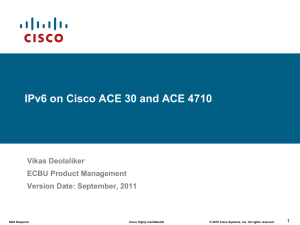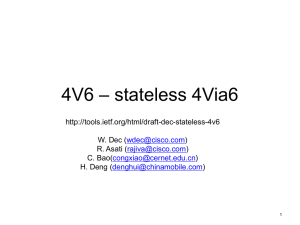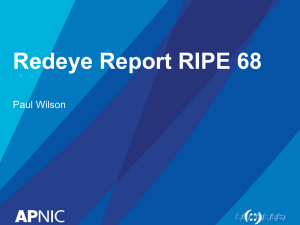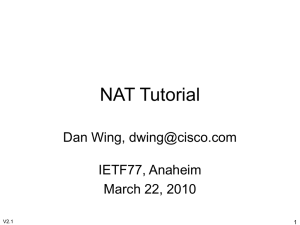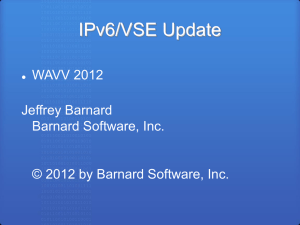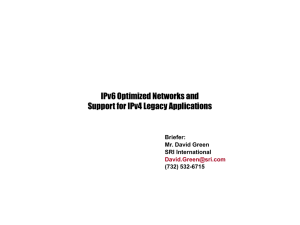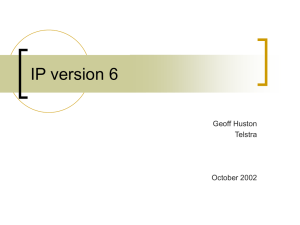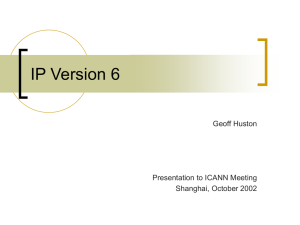10.2mb PPT - WatchGuard Technologies
advertisement
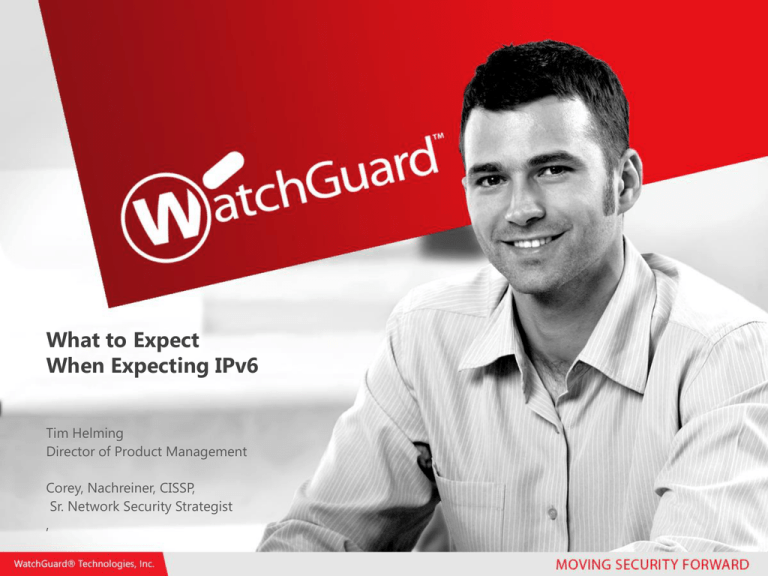
What to Expect When Expecting IPv6 Tim Helming Director of Product Management Corey, Nachreiner, CISSP, Sr. Network Security Strategist , Welcome to WatchGuard’s IPv6 Webinar Series! 1 2 3 4 What To Expect from IPv6 You’re here because v6 matters to you We’re here to help! Things we’ll answer: • What ISPs are doing today with IPv6 • How to prepare your own network Part 1: Current IPv6 Readiness IPv6 Readiness Growing daily …but still a drop in the bucket Remember this? Hasn’t changed much! Breadth, not depth All regions are participating Traffic Volumes Low Source: Elise Gerich, IANA/ICANN WIPv6D: Native v6 traffic nearly doubled! From .025% of all traffic …to… .041% of all traffic Source: http://asert.arbornetworks.com/2011/06/world-ipv6-day-final-look-and-wagons-ho/ ISP IPv6 Readiness Varies Greatly A few are 100% ready Many are getting close A few are just not there at all—still planning Bottom Line: Your ISP may not have all the answers, yet… …but they are eager to talk v6 More Detail in Part 2 today! Part 2: Three Steps to IPv6 Three Steps to Implementing IPv6 Research and Discovery Planning & Migration Strategies Implementation & Transition Research and Discovery Find the Answer to Three Questions Does your ISP support IPv6? What’s your network look like today? What needs an upgrade? (or a transition technology) The State of IPv6 Among ISPs Your ISP is your gateway to the Internet. As such, the IPv6 migration strategies available to you depend heavily on what IPv6 services your ISP offers today. Native IPv6 support IPv6 transition services IPv4 only (v6 is your problem) Real-World IPv6 Readiness: An ISP Survey RFC 6036: Emerging Service Provider Scenarios for IPv6 Deployment 30 ISPs Participated Served from 30 customers to 40 million 66% EMEA, 20% N.Amer, 4% APAC Published 2010 ISP Survey Trends and Highlights Big Customers Requesting IPv6 Current IPv6 Customers Support UseYes IPv6 No 1% 0% No 40% 40% Yes 60% 60% Use IPv4 99% •Estimated IPv4 depletion 2015 •93% plan Dual-stack backbone •40% run or plan to run 6to4 relay •CPE often doesn’t support IPv6 •Prefixes offered: •/48 most common •/64 (especially among mobile) •/56 •/52, /60 sometimes A Quick Look at N. American ISPs • Testing internally w/FIOS network April 2010 • IPv6 running on back end • Offer transition service for businesses • Have started public trials • Offered Tunneling in Phase 1 • Moving to Dual stack CPE • One of the best US options for residential IPv6 today • Supports dual-stack • Limited customer trials during 2011. • Will offer businesses IPv6 DIA Sept. 2011 • Expects full support 1H 2012. Comcast Time Warner • No clear time frame for IPv6 support • (but they say they’ve been working on it) • IPv6 trials with Business Customers • IPv6 at core • Says they will extend trials soon. • IPv6 in core • Offers IPv6 trials to business customers • MPLS supports IPv6 Rogers Cox Qwest/CenturyLink Verizon Hurricane Electric is a global Internet backbone provider (and transit ISP), with a specific focus on IPv6 The largest IPv6 backbone in the world First to connect 1000 IPv6 networks Offers a free IPv6 tunnel broker service Offers a free IPv6 certification service Offers a free, IPv6 capable DNS service RECAP: IPv6 Hierarchical Addressing Global Routing Prefix Prefix SLA ID Interface ID 2561:1900:4545:0003:0200:F8FF:FE21:67CF RIR NIR/LIR IPv6 Subnetting •CIDR only (slash notation) •No concept of subnet masks •/ followed by prefix size (decimal number 1-128) 2001:1900:4545:0003:0200:F8FF:FE21:67CF /16 /32 /48 2001:1900:4545::/48 = 2001:1900:4545:0000:0000:0000:0000:0000 2001:1900:4545:FFFF:FFFF:FFFF:FFFF:FFFF CIDR to range tool: http://www.ultratools.com/tools/ipv6CIDRToRange Regional Internet Registry (RIR) Current ARIN IPv6 Blocks: 2001:1856:4A5f::/64 •2001:0400::/23 •2001:1800::/23 •2001:4800::/23 •2600:0000::/12 •2610:0000::/23 Local Internet Registry (LIR) ARIN IPv6 Block: 2001:1800::/23 ISP IPv6 Blocks: •ISP A •2001:1800::/32 •ISP B •2001:1801::/32 •ISP C •2001:1802::/32 ISP A ISP C 2001:1800:1234::/64 ISP B 2001:1802:1234::/64 The Multi-Homed Issue: PA vs. PI Provider Aggregated Addressing (PA) • Temporary address block provided by ISP/LIR. • Follows prefix hierarchy. • Readily available addresses • You lose the address block when you leave the ISP Provider Independent Addressing (PI) • Permanent address block provided by RIR (sometimes through LIR) • May break prefix hierarchy and require interdomain routes • Not as readily available • You keep the address block forever. Map Your Network You should identify: •Your core infrastructure (routers, switches, etc) •Security devices •Hosts and OSs on your network •Enumerate you DNS and DHCP servers •Your application servers (Public & Private) •Other networks devices (printers, NAS, etc..) What Needs an Upgrade? The goal of the previous network enumeration process is to figure out what supports IPv6 and what does not. Place in three buckets: •No support •Partial support •Full support (w/dual-stack) Devices lacking support will require eventual upgrade or transition services Planning and Migration Strategies Planning and Migration Strategy By now, you should know: • If you ISP supports native IPv6, Tunnels, or only IPv4 • How many devices are ready for IPv6 • Which devices support dual-stack • What mission critical applications you serve IPv6 Transition Technologies •Dual-Stack: IPv4 and IPv6 run together on all/most devices. DualStack routing devices can handle translation, if necessary •Tunneling: Allow IPv6 devices to communicate over an IPv4 network via tunnels (a lot like VPN) • Manual: Require configuration. More control, thus more secure • Automatic: Little setup. May sneak out your network • Tunnel Brokers: Companies that offer easy IPv6 tunneling services •Translation: Re-writing one protocol packets to another protocol (IPv6 to IPv4, and vice versa). •Application-specific proxies: Translation only for specific services (web, email, etc). IPv6 client connects to proxy server, it makes IPv4 connection to a service… Common Tunneling and Translation Protocols Tunnel Protocols • 6to4 (Auto) • Teredo (Auto) • ISATAP (Auto) • 6rd (Auto) • 4in6 (Configured) • 6in4 (Configured) Translation Protocols • Stateless IP/ICMP Translation (SIIT) • NAT64 • DNS 64 • Dual-stack Lite (DSLite) • NAT-PT (depreciated) Three Migration Strategies Core Migration Application/Server Migration Client-Side Migration A Simplified Network Internet ISP IPv4 Core Network IPv4 Network (LAN) IPv4 Network IPv4 Network (DMZ) IPv6 Tunnel broker or endpoint Core Migration Internet IPv6 IPv4 ISPISP IPv6 Routers (or Dual-stack) IPv6 IPv4 Core Network IPv4 Network (LAN) IPv4 Network Dual-stack Routers IPv4 Network (DMZ) Application Server Migration Internet ISP IPv4 Core Network IPv4 Network (LAN) IPv4 Network Depending on ISP capabilities, Tunneling or Translation services used for IPv6 Internet access. IPv4 IPv4/IPv6 Network Network (DMZ) Client-side Migration Internet ISP Again, Tunneling or Translation services used where needed IPv4 Core Network IPv4 IPv4/IPv6 Network Network (LAN) IPv4 Network IPv4 Network (DMZ) Implementation and Transition IPv6 Deployment: Eating the Elephant “[IPv6 deployment] is very much an ’eating the elephant’ problem, but at one mouthful at a time, it appears to be surprisingly easy. Just do it, bit by bit." From Islands to Oceans IPv4 Island Internet IPv4 Island Even if you converted to full IPv6 tomorrow, you will still need translation tech until everyone does IPv6 Network IPv4 IPv6 IPv4 Ocean network IPv6 Ocean IPv6 Island Expect a Long-term Transition Phase Plan at least a 10 year IPv6 Transition phase • It will actually take some organizations years to fully convert to IPv6 • More importantly, even if you convert your entire network to IPv6-only tomorrow, you will still need to leverage 4to6 translation technologies to allow the rest of the world to connect to you until they catch up! Wrapping Up It’s Up To You! ISPs are responding to customer demand (somewhat unevenly) You have choices (ISPs, internal network configuration) Your transition can start today, and can happen swiftly Resources for further reading: • “0 to IPv6 in 3 Months” Case Study (PDF): goo.gl/jpnX7 • ARIN Number Resource Policy: http://goo.gl/G5fse • World IPv6 Day Experiences: http://goo.gl/kGeQa • RFC 6036 - Emerging Service Provider Scenarios for IPv6 Deployment: http://goo.gl/WSMzR •IPv4-to-IPv6 Transition Strategies: http://goo.gl/8GOzJ •IPv6 Transition Strategies: http://goo.gl/U5iV6 •IPv6 Calculator Tools: http://goo.gl/OqDw5 Thank You!

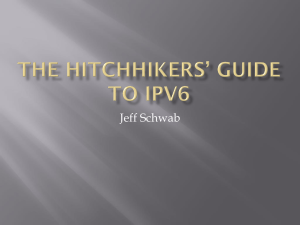

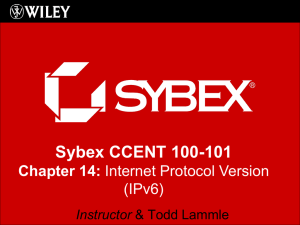

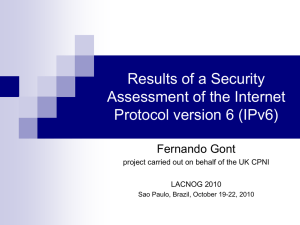
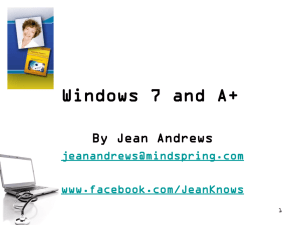
![IPv6[1]](http://s2.studylib.net/store/data/005281349_1-180d2db5384c16fc00944abde40d10a1-300x300.png)
